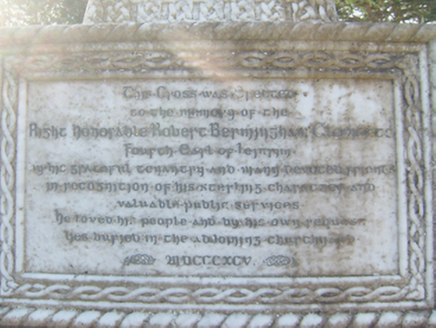Survey Data
Reg No
40808005
Rating
Regional
Categories of Special Interest
Architectural, Artistic, Historical, Social
Original Use
Monument
In Use As
Monument
Date
1890 - 1900
Coordinates
213202, 436726
Date Recorded
29/09/2010
Date Updated
--/--/--
Description
Freestanding Celtic high cross memorial, dated 1895, commemorating the Fourth Earl of Leitrim of nearby Mulroy House (see 40901712). Restored and re-erected in 1997. Sicilian white marble cross with Celtic interlacing in relief to faces and sides, and with carved heads and zoomorphic figures to bosses to arms of cross. Cross set on splayed marble pedestal with Celtic interlacing to three sides and inset leaded lettering to front face (north) reading "This cross was erected to the memory of Robert Bermingham Clements, 4th Earl of Leitrim, by his grateful tenants and many devoted friends, in recognition of his sterling character and valuable public services. He loved his people and by his own request lies in the adjoining churchyard". Cross set on rendered plinth (on square-plan) having three steps. Monument set in rectangular enclosure having wrought-iron railings with cast-iron finials over rendered plinth wall. Gateway to the north side comprising a pair of cast-iron gate posts with wrought-iron pedestrian gate. Located on a corner site in the centre of Carraig Art [Carrickart] with green area\park adjacent to the south with Church of Ireland church (see 40808002) located to the south side.
Appraisal
This very fine and imposing white Sicilian marble Celtic high cross monument is a sculptural\artistic work of high quality with rich Celtic interlacing motifs throughout and with intricate carved figures to the principal face. It was erected in 1895 as a memorial to Robert Bermingham Clements (1847-1892), Fourth Earl of Leitrim, of nearby Mulroy House (see 40901712). A plaque to the pedestal to the principal face records that it was erected by ‘his grateful tenants and devoted friends’. He is buried in the adjacent graveyard of Holy Trinity Church (see 40808002). The Fourth Earl was a popular figure in the area (in contrast to his notorious predecessor who was murdered in 1878), and he carried out extensive works during the 1880s including extensions to Mulroy House, the addition of multiple estate houses and ancillary structures throughout the estate, piers and shipping services along Mulroy Bay, as well as various improvements throughout his estates and in Carraig Art [Carrickart] that provided employment. It uses the traditional Irish symbol of a Celtic high cross with Celtic interlacing, perhaps a slightly unusual motif for a "landlord" at the time. The brief for the project (advertised in 1892) stipulated that the monument to the Earl would be in the form of a "Celtic cross", that it would be 'erected near his grave...in its locality is both conspicuous and suitable' (Irish Builder December 1892). It was apparently designed by the Belfast architectural partnership Young and Mackenzie (Irish Architectural Archive), one of the leading firms in Ulster at the turn of the twentieth century. According to local information the cross blew over in a storm c. 1974 and was in storage for over 20 years before being re-erected in 1997. This very fine monument forms an integral element of a large group of structures and features associated with the Earls of Leitrim and nearby Mulroy House, and is a significant element of the built heritage of the local area in its own right, adding artistic and historic interest to the streetscape to the north-east end of Carraig Art [Carrickart]. The wrought-iron railings and metal gateway to site add to the context and setting, and are examples of the high-quality of late nineteenth-century craftsmanship.









